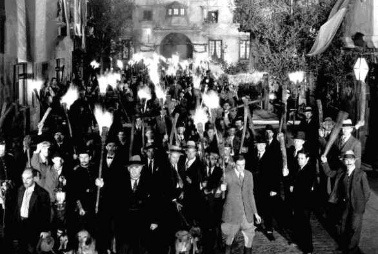The story so far… the hero of the movie has, in an unexpected plot twist, turned out to be the villain. A torch-and-pitchfork-wielding mob have gathered, and are baying for blood. Meanwhile, the villain remains trapped in his castle, remaining resolutely silent. We now await the dramatic conclusion… will the villain seek redemption, or will he be torn limb from limb by the angry crowd?
 The hero/villain is, of course, Netflix (hence the tenuous horror movie analogy). As has been reported extensively elsewhere, Netflix has angered its customers by introducing a new pricing plan which amounts to a 60% increase for many customers. While I write this, the blog post describing this has 5000 comments (the maximum Blogger allows), 10,631 comments in the Facebook widget, and an astonishing 57,091 comments on their Facebook page; few of them are very positive.
The hero/villain is, of course, Netflix (hence the tenuous horror movie analogy). As has been reported extensively elsewhere, Netflix has angered its customers by introducing a new pricing plan which amounts to a 60% increase for many customers. While I write this, the blog post describing this has 5000 comments (the maximum Blogger allows), 10,631 comments in the Facebook widget, and an astonishing 57,091 comments on their Facebook page; few of them are very positive.
As I don’t live in the US, I can’t subscribe to Netflix, so I have watched the story unfold as an interested bystander. I’ve been surprised by the anger that has been provoked by a $6 per month increase, especially as is fairly widely known that Netflix have been forced into paying studios much higher rates for content. But there’s no doubt that there is genuine anger there, somewhat exacerbated by the initial response from Netflix “30,000 or so is a subset of 23 million subscribers. They’re not speaking for the majority.”
This has all the hallmarks of a social media horror story, the latest in a long line of cases where a company has established a social media presence but is ill-equipped to handle a torrent of negative feedback.
As luck would have it, I was speaking at an Enterprise 2.0 webinar yesterday, and I took the opportunity to ask our guest speaker, Sameer Patel, about Netflix’s predicament. His answer was, for me, the highlight of the webinar, because of the way he managed to see the positive opportunity that Netflix have. Sure, he said, they have a lot of angry customers, and social media has given these customers strength in numbers. But it has also given Netflix far more rapid access to this feedback, and presented them with an opportunity to respond and fix the problem quickly. Five years ago, this wouldn’t have been possible – social media has massively shortened the feedback cycle, and given companies the information they need to react quickly.
Of course, to be able to take advantage of this opportunity, the company needs to be set up to listen to their customers and factor this into their decision making. In our recent Clearvale SecondFloor event in Boston, Paul Greenberg talked about how the Comcast Cares program fails in this respect, because it is perceived within the company as PR. Indeed, this was this subject of yesterday’s webinar, The Connected Enterprise, ensuring that your company is “wired internally” to meet the needs of your customer.
Whether Netflix will take advantage of this opportunity, I have no idea, and I don’t presume to tell Netflix its business. But it’s a useful reminder that right up until the very end of the movie, there is still time for a final plot twist and a happy ending.
